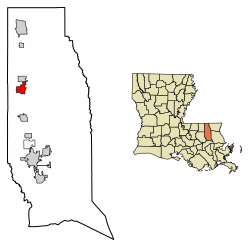Amite City, Louisiana
Amite City, Louisiana | |
|---|---|
| Town of Amite City | |
 Blythewood Plantation House | |
 Location of Amite City in Tangipahoa Parish, Louisiana. | |
 Location of Louisiana in the United States | |
| Coordinates: 30°43′43″N 90°30′31″W / 30.72861°N 90.50861°WCoordinates: 30°43′43″N 90°30′31″W / 30.72861°N 90.50861°W | |
| Country | United States |
| State | Louisiana |
| Parish | Tangipahoa |
| Incorporated | March 7, 1861 |
| Government | |
| • Mayor | Walter Daniels III |
| Area | |
| • Total | 3.89 sq mi (10.08 km2) |
| • Land | 3.88 sq mi (10.04 km2) |
| • Water | 0.01 sq mi (0.04 km2) |
| Elevation | 115 ft (35 m) |
| Population (2010) | |
| • Total | 4,141 |
| • Estimate (2019)[2] | 4,436 |
| • Density | 1,144.18/sq mi (441.74/km2) |
| Time zone | UTC-6 (CST) |
| • Summer (DST) | UTC-5 (CDT) |
| ZIP Code | 70422 |
| Area code(s) | 985 |
| FIPS code | 22-01885 |
| Website | www |
Amite City (/eɪˈmiːt/ ay-MEET or /eɪˈmɪt/ ay-MIT; commonly just Amite) is a town in Tangipahoa Parish, of which it is the parish seat, in southeastern Louisiana, United States.[3] The population was 4,141 at the 2010 census. It is part of the Hammond Micropolitan Statistical Area.
History[edit]
The original settlement was born on the banks of the Tangipahoa River, adjacent to a Choctaw Indian village. Legend has it that the site was chosen when Choctaw Chief Baptiste welcomed the earliest settlers. Baptiste was the last Choctaw chief in the region. "Amite" has been said to be a Choctaw word for "red ant", signifying "thrift" or to have meant "friendship", from the French, "amité."
Portions of present day Amite City were entered from the United States as early as 1813.
In 1852 the New Orleans, Jackson, and Great Northern Railroad was chartered in both Louisiana and Mississippi. Two years later, the railroad was opened from New Orleans to the state line. Amite City was chosen as the practical stopping point as it was halfway between Lake Pontchartrain and the Mississippi state line.
Amite City was chartered in 1855. The town was laid out, lots were sold and the community quickly began to grow. The Hotel Ponder at the "Amite Station" became a popular spot among travelers for dining and relaxing. In addition to becoming a major commercial center for a large region, Amite Station also became a popular resort in the late 1850s. Many prosperous New Orleans residents established country retreats in the region to enjoy the natural beauty and escape unhealthy conditions in the city. This trend intensified as the scourge of yellow fever continued to plague New Orleans in the mid 19th century.
On March 7, 1861,[4] Amite City was incorporated as a town, just months after the secession of Louisiana from the Union. During the war, Amite City served as an important gathering spot for Confederate officials involved in the supply and support of Camp Moore, the largest Confederate training base in Louisiana, just 10 miles to the north. Amite endured at least two visits by Union cavalry. In 1864 a brigade of Union infantry burned the railroad depot and destroyed the track from the depot to Camp Moore.
After the war, Amite City served as the base for Union troops occupying the region during Reconstruction. With the establishment of a new parish in 1869, soon to be named Tangipahoa, Amite City was selected as the parish seat. Five different buildings have served as the courthouse since 1870.
From the early 1870s through the first decade of the 20th century, Amite City played a central role in the troubles that unfortunately gained the parish the ominous name "Bloody Tangipahoa." The turbulent political and economic conditions of the Reconstruction period and its aftermath sparked a number of vicious family feuds. Numerous duels and "bushwhacking" occurred in the streets of Amite City and the countryside. By the early 20th century, improved law enforcement brought peace and better harmony to the area.
Amite City continued to grow as a trading center for cotton planters and others. In 1869, the Gullet Gin Company opened in Amite City. The company was the largest producer of cotton gins in the south, employing over 250 people by the early 20th century. During World War II, the plant converted to war industry production, manufacturing 150 mm shells. The plant closed in 1963.
In the mid-20th century, family dairy farms began to replace cotton farms. Today, Tangipahoa Parish is the heart of Louisiana's dairy industry and is the number one producer of strawberries in the state. Amite City is also a major oyster processing center and home of the Oyster Festival.[5]
Geography[edit]
Amite City is located at 30°43′43″N 90°30′31″W / 30.72861°N 90.50861°W (30.728718, -90.508519).[6]
According to the United States Census Bureau, the town has a total area of 3.9 square miles (10 km2), of which 3.8 square miles (9.8 km2) is land and 0.04 square miles (0.10 km2) (0.52%) is water.
Demographics[edit]
| Historical population | |||
|---|---|---|---|
| Census | Pop. | %± | |
| 1870 | 910 | — | |
| 1880 | 1,120 | 23.1% | |
| 1890 | 1,510 | 34.8% | |
| 1900 | 1,547 | 2.5% | |
| 1910 | 1,677 | 8.4% | |
| 1920 | 1,854 | 10.6% | |
| 1930 | 2,536 | 36.8% | |
| 1940 | 2,499 | −1.5% | |
| 1950 | 2,804 | 12.2% | |
| 1960 | 3,316 | 18.3% | |
| 1970 | 3,593 | 8.4% | |
| 1980 | 4,301 | 19.7% | |
| 1990 | 4,236 | −1.5% | |
| 2000 | 4,110 | −3.0% | |
| 2010 | 4,141 | 0.8% | |
| 2019 (est.) | 4,436 | [2] | 7.1% |
| U.S. Decennial Census[7] | |||
As of the census[8] of 2010, there were 4,141 people, 1,310 households, and 810 families residing in the town. The population density was 1,066.2 people per square mile (412.2/km2). There were 1,450 housing units at an average density of 376.1 per square mile (145.4/km2). The racial makeup of the town was 43.59% White, 54.50% African American, 0.12% Native American, 0.56% Asian, 0.36% from other races, and 0.87% from two or more races. Hispanic or Latino of any race were 1.50% of the population.
There were 1,310 households, out of which 32.4% had children under the age of 18 living with them, 40.4% were married couples living together, 26.0% had a female householder with no husband present, and 29.3% were non-families. 26.6% of all households were made up of individuals, and 12.0% had someone living alone who was 65 years of age or older. The average household size was 2.66 and the average family size was 3.23.
In the town, the population was spread out, with 25.3% under the age of 18, 12.3% from 18 to 24, 28.0% from 25 to 44, 21.1% from 45 to 64, and 13.3% who were 65 years of age or older. The median age was 34 years. For every 100 females, there were 111.2 males. For every 100 females age 18 and over, there were 111.6 males.
The median income for a household in the town was $27,011, and the median income for a family was $33,125. Males had a median income of $30,590 versus $19,063 for females. The per capita income for the town was $14,565. About 23.1% of families and 27.0% of the population were below the poverty line, including 39.3% of those under age 18 and 14.3% of those age 65 or over.
Education[edit]
Public - Tangipahoa Parish School Board operates three public schools in Amite:
- Amite High Magnet School
- West Side Middle School
- Amite Elementary School
Private
- Oak Forest Academy is a private school for children in Pre-K through 12th grade.
Notable people[edit]
- Rusty Chambers, NFL football player
- John Bel Edwards, 56th (and current) Governor of Louisiana; former Minority Leader of Louisiana House of Representatives; former District 72 state representative; United States Military Academy graduate
- Bolivar Edwards Kemp, Jr., Louisiana Attorney General from 1948–1952
- Bolivar Edwards Kemp, Sr., U.S. Representative from 1925–1933
- Kevin Magee, basketball player who competed professionally in Europe
- Reggie Porter, football player for Utah Utes, NFL teams (Indianapolis Colts, Baltimore Ravens, Cleveland Browns)
- Lloyd Pye, research coordinator of the Starchild Project; author, researcher, and lecturer in the field of alternative knowledge
- Billy Reid, fashion designer
- Lester Ricard, football player for the Tulane Green Wave, who tried out for the NFL's Jaguars and Panthers
- DeVonta Smith, Philadelphia Eagles football player and 2020 Heisman Trophy winner
- Joanne Verger, Oregon legislator and first woman to serve as mayor of Coos Bay, Oregon
- Lavelle White ("Miss Lavelle"), American Texas blues and soul singer
- Harry D. Wilson, former state representative and Louisiana Commissioner of Agriculture and Forestry; interred at Amite Cemetery[9]
- Karl Wilson, NFL football player
See also[edit]
| Wikimedia Commons has media related to Amite, Louisiana. |
References[edit]
- ^ "2019 U.S. Gazetteer Files". United States Census Bureau. Retrieved July 25, 2020.
- ^ a b "Population and Housing Unit Estimates". United States Census Bureau. May 24, 2020. Retrieved May 27, 2020.
- ^ "Find a County". National Association of Counties. Archived from the original on 2011-05-31. Retrieved 2011-06-07.
- ^ "Tangipahoa Centenial Book, 1869-1969".
- ^ townofamitecity.com History Archived 2015-12-08 at the Wayback Machine
- ^ "US Gazetteer files: 2010, 2000, and 1990". United States Census Bureau. 2011-02-12. Retrieved 2011-04-23.
- ^ "Census of Population and Housing". Census.gov. Retrieved June 4, 2015.
- ^ "U.S. Census website". United States Census Bureau. Retrieved 2008-01-31.
- ^ "Amite Cemetery". findagrave.com. Retrieved May 2, 2013.


No comments:
Post a Comment